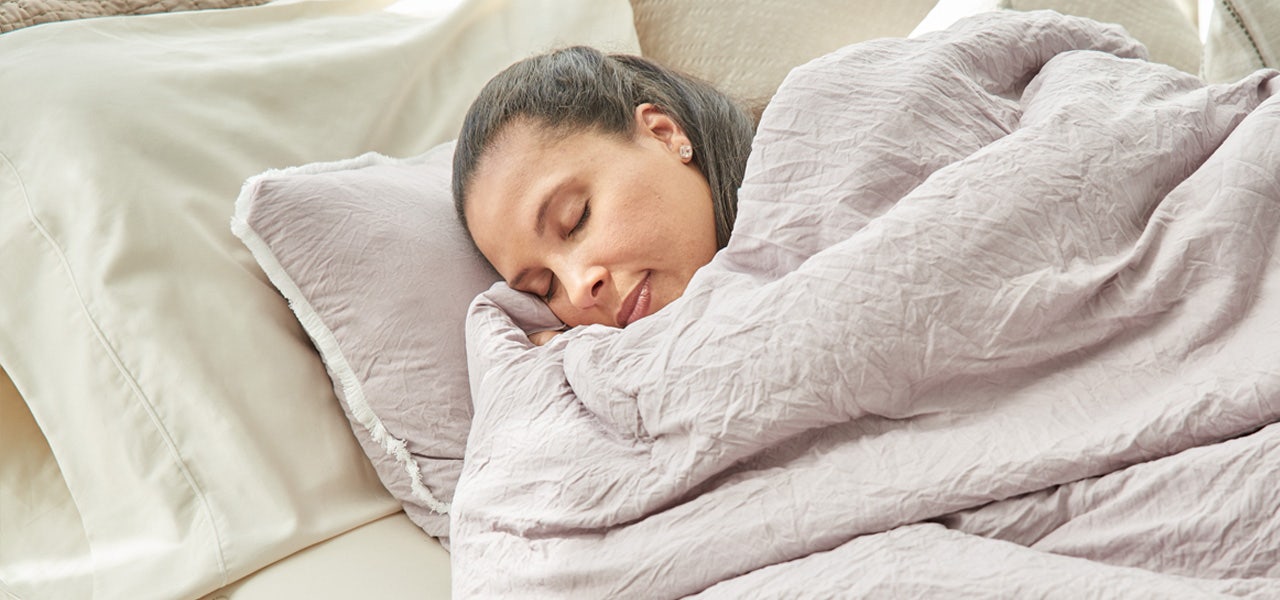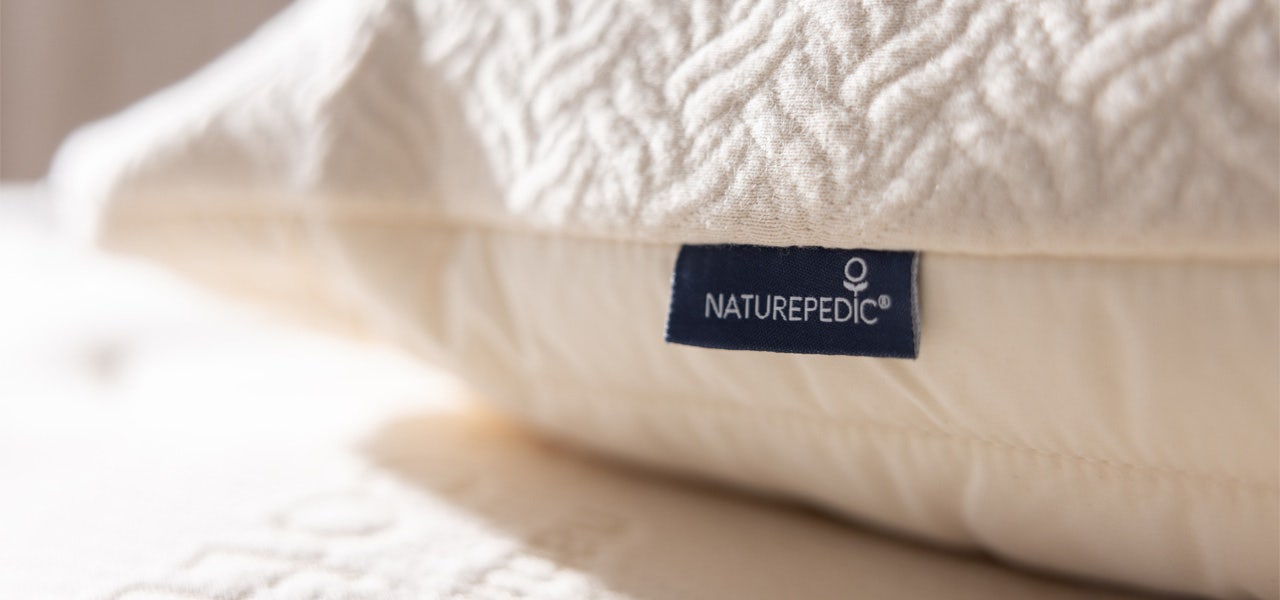Have you ever noticed that your old pillow has turned yellow? It’s not a pretty sight … nor is the reason behind it. Why do pillows turn yellow?
Sweat. Drool. Oil from your skin and hair. Check, check, double check! Go ahead and add in residue from cosmetics, hair products and moisturizers. And if your pillow has enough moisture buildup to turn yellow, then it’s probably safe to assume there are other not-so-nice things lurking, too: dust mites, allergens and even bacteria (that’s right, moisture makes the perfect breeding ground for bacteria).
Discoloration isn’t the only sign that it may be time for a new pillow. Think comfort, shape, support … you know, the reasons we buy pillows in the first place! Despite best laid plans – like certified organic pillow protectors, washable pillows and high-quality, healthier materials – all pillows must be replaced eventually.
Here at Naturepedic, we know the difference that the right bedding can make on your sleep quality – and that includes your pillow! We’re happy to share our expertise to help you identify when it’s time to replace your pillow (and maybe even point you in the direction of your next pillow along the way.
How Long Do Pillows Last?


If you Google “how long do pillows last,” you’ll see the consensus is 1-2 years. However, how long your pillow actually lasts depends on two main factors:
- What type of pillow you have
- How well you take care of it
Pillow Materials Matter
As for type of pillow, if we’re not talking strictly GOTS certified organic, there are many different options. Some common types of pillows include:
- Polyester or down alternative
- Down or feather
- Polyfoam or memory foam
- Natural or synthetic latex
Polyester or down alternative pillows are the most cost-effective options, but they tend to need replacing the soonest (same goes for down and feather pillows on the early replacement issue). Memory foam pillows last longer but can contain potentially hazardous chemicals and flame retardants. If you’re a health-conscious or eco-conscious shopper, you’ll want to avoid foams.
Oh, and here’s a tip: memory foam pillows trap heat and can make you feel extra hot and sweaty at night. Opting for naturally breathable organic pillows can help reduce those night sweats.
For adults looking for a pillow with a longer lifespan and a safer, healthier composition, the best pillow fill type is GOTS-approved latex made from the sap of rubber trees. These pillows can last two to four years and are an excellent alternative for those looking to avoid memory foam and chemical flame retardants. Just be aware that some people have a latex allergy, so if you know you have one, opt for a different fill material. For this same reason, Naturepedic recommends latex pillows for adults only – because you might not know yet if your child has a latex allergy, and the place they rest their head each night is not the place to find out if they do!
To make sure you’re buying the best option, look for certifications such as:
- GOTS certified – Organic certification for the entire pillow
- GOLS certified – Organic certification for the latex fill
- FSC® certified by Preferred by Nature – Certifies that the natural latex comes from sustainably managed forests
At Naturepedic, we say that it isn’t organic unless it’s certified organic!
Pillow Care Factors
You should always sleep with a pillowcase and care for your pillow according to the care instructions on its tag. If it’s washable, wash it regularly. If it’s spot clean only, stay on top of that. Washing your pillowcases and sheets at least once a week helps, too. You can also invest in a pillow protector to extend your pillow’s lifespan.


Why It's Important to Replace Your Pillow
Seeing yellow and brown stains on your pillow will make you want to replace it ASAP – it just looks gross! But the importance of replacing your pillows stretches so far beyond aesthetics.
Comfort and Support
What’s the number one thing most of us look for in our bedding? Comfort, of course! Over time, even the highest quality pillows lose their shape and become less comfy and less supportive. You may need to replace your pillow if you’re regularly waking up with stiffness or pain in your neck and shoulders.
Poor head and neck support can lead to lasting health problems, so it’s important to replace your pillows as they become less supportive over time. In addition, quality sleep is imperative to a healthy lifestyle. So, if your pillow is impeding your sleep, then it’s time for a new pillow.
Good Hygiene
Beyond comfort that you just can’t sacrifice, replacing your pillow is an important part of maintaining proper hygiene. Old pillows collect dust, dead skin cells, hair, make-up residue and sweat. This can cause bacteria to build up, for starters. It can also cause unpleasant reactions for those with allergies and can lead to or exacerbate acne conditions. Regularly replacing your pillow ensures cleaner and healthier sleep.
5 Signs It's Time for a New Pillow
Just like the rest of our bedding, our pillows weren’t built to last forever – we use them every night, after all! So, how do you know when it’s time to replace your pillow? Here are five key signs that your pillow is probably well past its prime:
- Discoloration – Remember, a yellow pillow means a build-up of a whole slew of yucky stuff, posing hygienic and allergenic concerns
- Unpleasant smell – Similar to discoloration, if your pillow smells funky, it’s probably due to moisture build-up and bacteria.
- Lumpy or flat appearance – Your pillow’s fill material is either compressing or bunching up. Either way, it’s no longer offering the support it was designed to give.
- Neck/shoulder pain or stiffness – Your pillow is no longer helping to cradle your head and hold your body in proper spinal alignment. The result? Ouch.
- New or increased allergies – This is due to all those dust mites and other allergens you don’t want to sleep on every night.
How Naturepedic Can Help


There’s one more reason that you might want to replace your pillow: leading a healthier lifestyle. If you’re looking for a pillow that's tested for over 6,500 potentially hazardous chemicals per the MADE SAFE® standard, Naturepedic offers a variety of safer, healthier pillow and pillow protector options made from Mother Nature’s best materials.
Our GOTS certified organic pillow options are perfect for those looking for a long-lasting latex pillow – and did we mention that we have customizable options, too? For those who want an easy-to-clean pillow, our Organic Cotton/PLA Pillow features a washable cover and GOTS-approved PLA fill derived from non-GMO sugarcane. Since it’s made without allergenic latex, this one’s a great option for kids, too!
And for that extra layer of protection, Naturepedic’s certified organic pillow protector is waterproof and machine washable.
The bottom line? Your pillow plays a massive part in your overall sleep quality, and maintaining a clean and supportive pillow, made from healthier materials, is the best way to step in the right direction.
 BABY
BABY  KIDS
KIDS  ADULT
ADULT  LEARN
LEARN  STORES
STORES 